As one would expect, a myriad of solutions exists to deal with unsafe ammonia levels in your tank. Each solution offers a unique perspective on how to control ammonia levels in fish tanks, but most people only use the one that’s most accessible or easiest for them to follow. If you’re looking for more information on how to keep your fish tank healthy without putting too much time, effort, and energy into it, then you’ve come to the right place.
What Happens When Ammonia Levels Are Too High?
Ammonia poisoning is the result of high ammonia levels in fish tanks, and it can be lethal to young fish. One of the first signs of ammonia poisoning in fish is labored breathing. You might notice a fish breathing a lot faster than normal, or even at a right angle from their usual position. This is because ammonia damages the gill tissue, resulting in the fish having to breathe harder.
Other effects of ammonia poisoning are lethargy, clamped fins, and swollen eyes. While the fish are suffering from ammonia poisoning, their color may change into a more faded hue. If left untreated, young fish can die of ammonia poisoning even if there is no trace of it in the water. All this being said, high levels of ammonia can have various effects on the fish depending on the age, size, and species of the fish.
If you ever come across an ammonia problem in your tank, it’s always best to treat it immediately. The most effective cure for ammonia poisoning is to lower ammonia levels in your tank.
13 Effective Ways To Lower Ammonia Levels In Fish Tanks
Having discussed what happens when ammonia levels are too high, we’ll now examine some of the most effective ways you can lower ammonia levels in your tank.
1. Partial Water Change
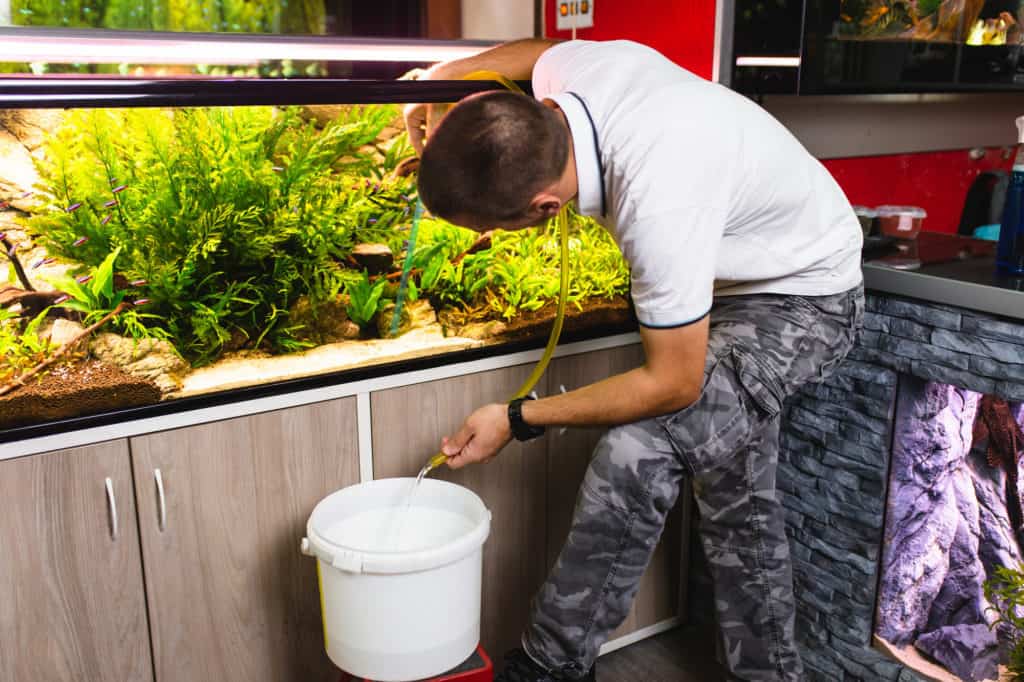
One of the first things you should do is to perform a partial water change in your tank. Since ammonia builds up in old, stagnant water, replacing part of the water will reduce the amount of harmful ammonia that you have to deal with. To do so, simply pour out some of the old aquarium water and replace it with clean, freshwater from your garden hose or tap.
If you intend to use tap water, you should make sure that it’s safe for your fish by using a water conditioner. Most conditioning products remove chlorine, ammonia, and other substances from tap water that are dangerous to your pets. Alternatively, you can also opt for specially formulated aquarium water from your local pet store. This will get rid of ammonia levels in your tank with minimal effort on your part.
You will need to perform water changes frequently to keep your fish healthy. We recommend doing a 30%-50% water change once every two weeks, or when the water becomes noticeably murky. Invest in an ammonia testing kit to know exactly when you should perform a water change, and remember to test your water frequently as you go through the water change process.
2. Remove Any Uneaten Food
High levels of ammonia can and are often caused by an excessive quantity of uneaten fish food. Excess food gives rise to waste buildup inside the tank, causing ammonia to proliferate very quickly. In addition, fish that are fed large quantities of food produce more waste, which also contributes to high levels of ammonia in your tank.
With this in mind, it is important to evaluate your and your fish’s feeding habits to assess the frequency of food you need to give your fish. In general, hobbyists provide no more than 2-3 feedings per day, with one feeding being about 1/4 of the daily recommended ratio. In addition, you should remove any uneaten food from your fish tank. Also, avoid overfeeding your fish in order to cut back on ammonia levels in your tank.
If you feed your fish once or twice daily, simply siphon out the excess food in the morning and evening while your fish are fast asleep. If you feed your fish more than twice daily, then siphon the excess food that they don’t eat within 1-2 minutes after each feeding. Do this one or two times per day to cut back ammonia levels in your tank.
3. Cycle Your Tank
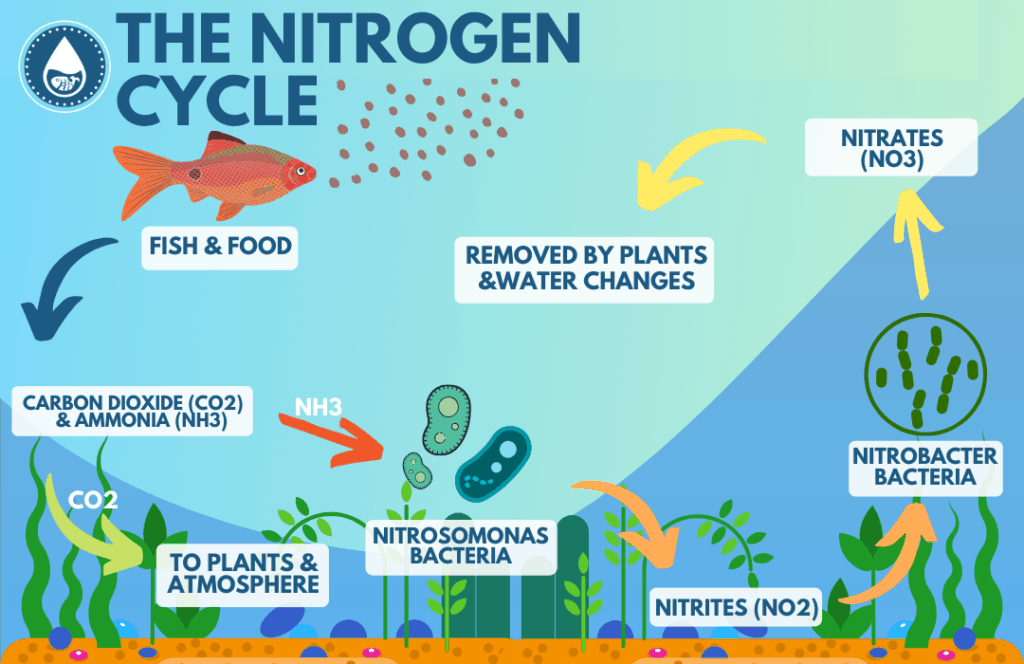
Tank cycling is the process of establishing a nitrogen cycle in your tank, i.e., creating the right conditions to allow the beneficial bacteria to grow and consume harmful ammonia. Nitrifying bacteria work by converting ammonia into nitrates. This process is beneficial for you since it helps maintain a safe level of ammonia in your tank.
The easiest way to cycle a new tank is to introduce substrate and filter media from a mature tank. These materials contain enough beneficial bacteria to make the nitrogen cycle start working as soon as you introduce them into your tank. Alternatively, you can buy a commercial product such as Bio-Spira from your local pet store. This will jumpstart the nitrogen cycle within 24 hours and lower ammonia levels in your tank.
If you’re cycling a new fish tank for the first time, we recommend that you do it in a separate aquarium while keeping your existing tank and fish safe. This way if something goes wrong with the cycling process and ammonia levels spike, you won’t harm your existing fish. For more info, check out this article on how to cycle a fish tank.
4. Remove Any Rotting Plants
When aquatic plants die, they create organic waste, which rapidly decomposes to produce ammonia. To lower the levels of this toxic substance, remove any dead plants from your tank immediately. Large pieces of dead plant matter are relatively easy to remove – you can either pull them out of the water using a net or skim and scoop them with a plastic ladle.
On the other hand, small fragments of decaying plants need to be siphoned out of the water. We recommend that you do so at least once per week to avoid deteriorating water conditions and high levels of harmful ammonia. Once you have siphoned out all the organic matter, we recommend that you use a gravel vacuum to remove any residual organic matter from your tank’s substrate.
The importance of removing decaying plants to lower ammonia levels in the fish tank cannot be understated. Not only do rotting plants produce harmful ammonia, they also clog up your filter intakes and cause cloudy water conditions.
5. Improve The Filtration
Nothing causes a spike in your ammonia test kit readings like dirty water filters. No matter which type of aquarium filter you use, it is essential that you avoid using dirty filter pads, as these collect debris, creating an ideal environment for ammonia-producing bacteria to thrive. Some types of filter bacteria are beneficial, but not when they form on dirty filter pads.
Similarly, the more debris is trapped in your filter, the harder it becomes for water to pass through them. This produces weak filtration which in turn decreases the rate of water flow in your tank. A low water circulation rate means that bad bacteria and ammonia can quickly spread through your fish tank. To lower ammonia levels in your fish tank, clean dirty filters once every 1-2 weeks.
If you’re using an under gravel filter, vacuum away any debris that has collected on the intake tube or around the filtration plate. If you’re using an internal type of filter such as a canister filter, remove and clean the filter cartridges. Once done, reinsert the cartridge and refill your tank volume up to 100%. Remember that different types of filter media need to be removed and cleaned at different intervals. This will keep problems related to bad filtration at bay!
6. Vacuum Your Gravel
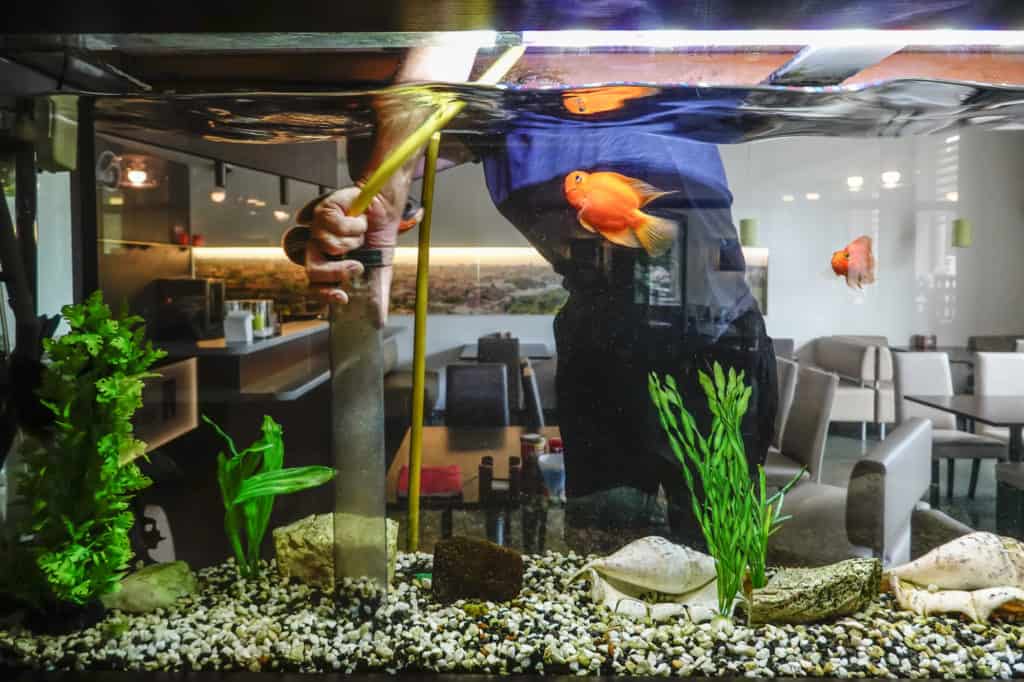
On top of keeping your fish tank filter clean, hobbyists who want to lower the levels of harmful ammonia in their tanks should also keep their substrate clean. Pond, gravel, and sand substrates produce organic waste more slowly than plant matter, but it’s important that you remove any fish waste or debris before it decomposes and raises ammonia levels in your water.
You can either vacuum the substrate directly every week or use a siphon to move the substrate around and remove any waste. If you’re using a gravel substrate, we recommend that you vacuum your aquarium gravel once every 1-2 weeks to prevent organic waste from building up in your fish tank.
A gravel filter system will also do the trick. This is not only good for your fish, but it’s great for helping remove debris from the gravel around your tank. If you’re using sand as substrate, simply siphon out any accumulated organic wastes onto a disposable cup or similar container every week.
7. Increase Aeration in the Tank
To prevent spikes in ammonia levels, you also need to increase the surface area of your aquarium water. Without proper aeration and high oxygen saturation level in your tank, organic waste will quickly decompose into harmful ammonia. Aerating your tank also helps with ammonia gas diffusion, as it causes ammonia to be released into the air around your tank.
The more aeration you provide, the better it is for keeping ammonia levels low. One good way to improve the aeration in your fish tank is by adding an air stone that produces bubbles in your tank. By creating small bubbles, the air stone helps increase the levels of dissolved oxygen found in your fish tank water. The higher the concentration of dissolved oxygen (DO) in your aquarium water, the less likely it is that harmful ammonia will be produced by decaying organic matter.
Another method is by using an aquarium pump to reduce water stagnation around your fish tank. Keeping the surface of your aquarium free from still waters is key in preventing ammonia stress in your fish. This is especially true if you have large fish with high oxygen requirements or multiple fish in a single tank.
8. Make Sure Your Tank Isn’t Overstocked
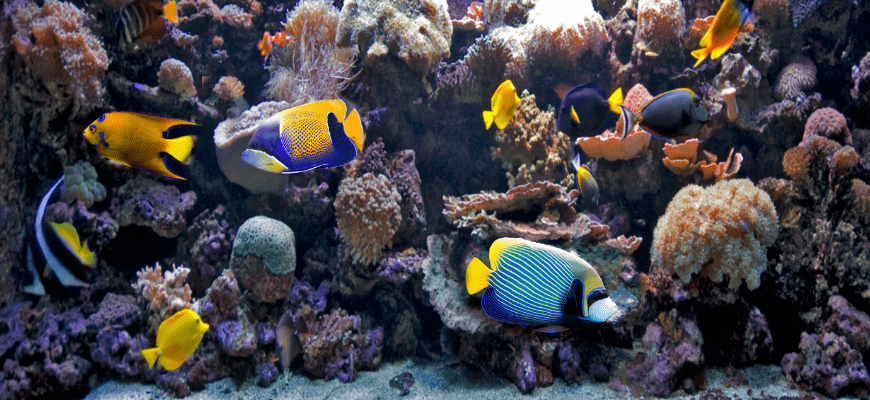
One of the first things you should look out for when your tank displays elevated ammonia levels is a large number of fish within a limited amount of water. Although it’s good to keep more fish in your tank, having too many fish that produce a lot of waste can result in high ammonia levels and lead to health problems for your fish.
The general rule is 1 inch of fish per gallon of water. Though this rule generally applies to tropical fish, it’s still a good starting point to prevent ammonia damage in your fish tank. For larger or more active fish, you may need up to 5 gallons of water per inch of fish. If your fish tank has a wide variety of different species, you can expect around 3-5 inches of space for every foot in length your fish tank is long. Check out this guide on stocking your tank for more specific tips!
Some hobbyists may point out that too little fish can lead to ammonia problems. This was a common claim when Goldfish were kept in bowls, but our understanding of fish behavior and their natural habitats has changed over the years, and we now know that this is not an effective way for keeping your tank clean or your fish healthy.
9. Upgrade To A Bigger Tank
A bigger tank is not necessarily a healthy tank, but upgrading to a larger-sized tank is a good, quick solution to high concentrations of ammonia. This is because a larger quantity of water means that ammonia concentration will be diluted faster. Simply adding more water to your tank can be enough to keep excess ammonia at bay.
Of course, simply upgrading to a bigger tank isn’t enough. This is only a temporary solution if your fish tank has insufficient filtration or aeration, as this will exacerbate ammonia concentration in your larger tank. If you’re looking to upgrade to a bigger aquarium, we recommend that you also upgrade the rest of the setup at the same time.
For example, using a large, hang-on-back (HOB) filter instead of a small HOB filter will improve the amount of oxygen and water circulation in your new tank, improving its overall efficiency. Furthermore, you can add an air stone to further increase oxygen levels in your larger aquarium, greatly reducing ammonia buildup.
10. Use Ammonia Removing Pellets In Your Filter
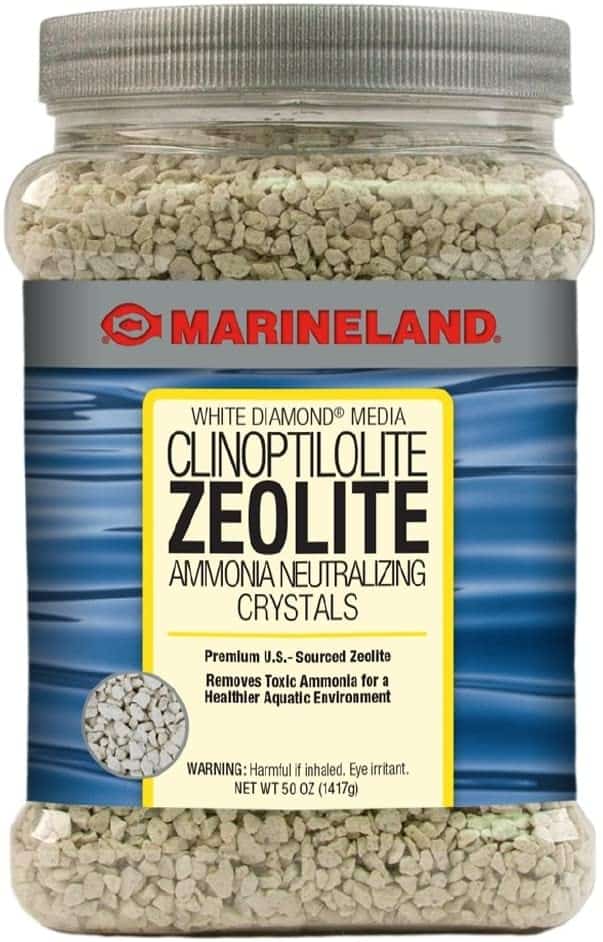
Ammonia removal products are usually only recommended as a last resort for tanks with high ammonia levels. As the name suggests, these products remove ammonia from your fish tank by chemically binding to it and causing it to be released through the water column. They get rid of ammonia quickly and effectively but carry the risk of stimulating more toxic nitrate production, which is a longer-term issue that can harm your fish over time.
That said, ammonia removers should only be used as a short-term solution if your fish tank has been overstocked or is too small to handle the amount of waste being produced by its inhabitants. For most aquarium owners, it’s best to avoid these chemical supplements because they can cause sudden changes in water parameters, which is harmful to your fish.
11. Keep Live Plants In The Aquarium
Believe it or not, aquarium plants can help lower ammonia concentrations in your tank! This is because these plants absorb excess nitrates as part of the aquarium nitrogen cycle, which strengthens the biological filtration in your tank. Over time, your aquarium plants can actually help remove excess ammonia from your water column, resulting in a clearer tank that’s free of toxic waste.
Remember that not all fish tanks are suitable for plant life – especially if you’re keeping saltwater fish! Groundcover varieties such as Java ferns and Anubias are good choices for freshwater aquariums, but you should keep in mind that they will need to be trimmed regularly. Also, because your fish will be spending a lot of time grazing on the plants’ leaves, your aquarium will need regular water changes to remove decaying plant material and replenish lost nutrients.
To help you maintain a healthy aquarium with plenty of fish and live plants, it’s also best to opt for hardy plants that are easily propagated. These plants can survive the occasional bite from hungry fish and continue to grow quickly, which means they’ll provide an extra source of plant nutrients for your aquarium over time. Examples of hardy plants include Java moss, water wisteria, and hornwort. Check out our list of plants that lower nitrate levels for more ideas!
12. Look For Any Dead Fish
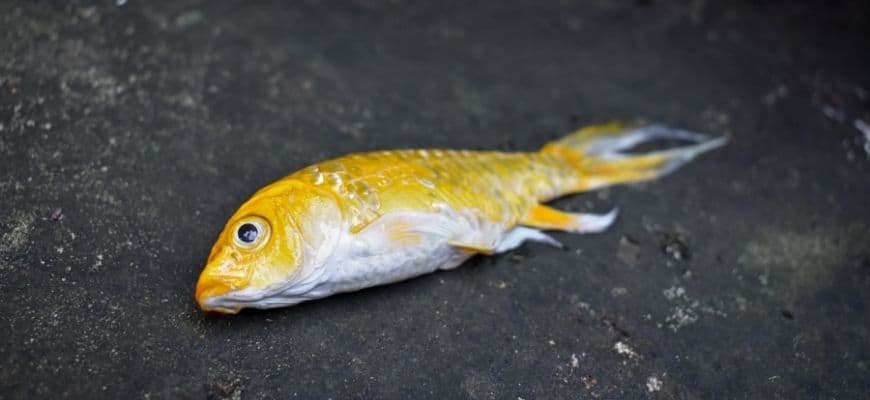
Here’s some bad news – If your water tests reveal a sudden and drastic ammonia spike, chances are, one of your fish has died. Dead fish are common culprits behind extreme ammonia levels because their decaying bodies release a large amount of waste into your aquarium. This waste contains ammonia, which finds its way into your aquarium water and causes a rapid increase in concentration.
If you do find a dead fish in your tank after an ammonia spike, remove it immediately! It’s not worth the risk of letting it rot in your aquarium because the harmful effects of the rotting body will remain even after its removal. The best way to handle a dead fish is to use a long pair of tweezers or forceps and remove it from your aquarium, taking care not to further damage the body in the process.
At this juncture, you should also observe other tank inhabitants for any signs of illness. Common symptoms include lethargy, failure to feed, and a loss of coloration. In some cases, you’ll also see extreme fin rot as a result of physical damage from the ammonia spike. If your fish show these symptoms after an ammonia spike, you need to act fast and carry out a large water change before the nitrate level increases.
13. Preserve The Beneficial Bacteria
When your fish tank experiences an ammonia spike, it’s always wise to avoid using chemical substances that can upset the beneficial bacteria in your aquarium. There are several different strains of these healthy bacteria, but most of them break down ammonia into nitrites – in a process called the nitrogen cycle. In addition to converting toxic ammonia into a less harmful substance, these bacteria also help convert nitrites into nitrates.
At this point, your goal will be to preserve the biological filter in your aquarium while you restore balance and reduce ammonia levels. The best way to do this is by carrying out small water changes on a daily basis, while simultaneously conserving your existing ammonia-eating bacteria by avoiding the usage of chemicals. This will give these beneficial bacteria time to regrow and multiply, helping your fish tank recover more quickly after an ammonia spike.
It’s also important to remember that not all healthy biological filters are capable of reducing ammonia on their own – so you will need to add more beneficial bacteria if the levels in your tank get too high. One way to add bacteria quickly and effectively is by using a filter pad with beneficial bacteria already built-in.
Conclusion
We hope these 13 tips about how to lower ammonia levels in fish tanks were helpful for you! The important thing is, if your ammonia level gets too high, don’t panic! Just follow these simple steps and everything will be okay in no time. Also, do your best to identify possible underlying causes of ammonia in the tank before a problem arises. This will make it easier to develop preventative measures in the future.
If you found this article helpful, please do share it with a friend who might be struggling with the same issues. You can also leave a comment to let us know how you dealt with ammonia spikes, and whether these 13 tips actually worked for your fish tank! Good luck and happy aquarium keeping!
